
The
offshore and specialised ships markets
in 2001 |
|
|
| |
|
2001 was overall positive for the different
sectors of the offshore business. Crude oil prices in fact remained at
strong levels for the first three quarters of the year, peaking over $30
per barrel in February and then fluctuating between a range of $23 to $28
until September. The events of September 11 have made the oil market's
future less certain and have highlighted and accentuated the economic
decline. As a result by the end of 2001, oil price has already
considerably dropped. Despite a certain stability around $17 / 18 per
barrel, there is nonetheless a drop in world energy demand and the global
economic situation is fragile.
With average oil price levels remaining on balance high, this has
encouraged putting into place large exploration and production budgets,
focusing mainly on the enhancement of oil and gas offshore fields in deep
waters. Technical innovations now allow seismic and geological studies to
be carried out at depths in excess of 6,000 metres at sea.
It is most unlikely that oil companies will suddenly curtail deep
offshore exploration and production. These fields are to be found
generally by definition far from the coastline and also outside
traditional land-based production zones (Middle East, CIS, Central
America), which puts them outside the risks of conflict which have
unfortunately traditionally prevailed in these regions, and also outside
the risks of land-based storage.
|
| Support
vessels: PSV (Platform supply vessels) and AHTS (Anchor handling tug
supply) |
|
|
The trend to develop oil and gas production in deep
waters continues to influence the key players in this industry who foresee a
sizeable increase in the offshore contracting services. It is accepted that
production in depths over 500 metres will significantly increase due to field
developments off Brazil, West Africa, and in the Gulf of Mexico. At the
beginning of the year, several offshore shipowners started to modernise their
fleet by ordering large units capable of operating in deep waters. Edison
Chouest ordered the world's largest AHTS: 347 feet long, 72 feet wide, 6,500
dwt. Tidewater also contracted with two shipbuilders in the Far East to build
eight ships. This owner has under construction four AHTS of 84 m with a power
of a minimum 20,000 bhp and two platform supply ships are due for delivery
between December 2001 and January 2003. Tidewater has announced a fleet
modernisation with the acquisition of 20 newbuilding units.
In addition, Rolls-Royce Marine has reinforced its position as a leader in
the area of naval architecture, engineering and associated equipment for supply
vessels, emphasising the success of its UT designs in the current market. The
Norwegian Aker Brattvaag for example, part of the Aker shipbuilding group, has
signed building contracts for 21 vessels, mostly UT designs, of which 14 were
ordered by the shipowner Gulf Offshore as part of the renewal of its fleet.
|
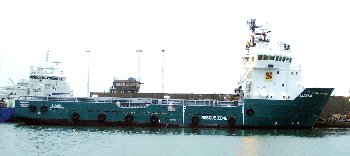 |
Luiana
UT755L type, blt 2001 by Orskov, owned by Sonasurf |
|
|
The success of the UT 755 design has led to 25
orders in a number of shipyards. This PSV of about 70 m in length, 5,500
bhp, and DP2 has become the ship of reference for anyone wanting to renew
their fleet, outside the North Sea, due to its versatility.
Swire Pacific Offshore, Singapore, after ordering four AHTS in Norway
in 2000, has placed an order with the Korean INP for four AHTS UT 738 of
10,000 bhp, 16 knots, 130 tons bollard-pull capacity, for a total cost of
$73.2 million.
|
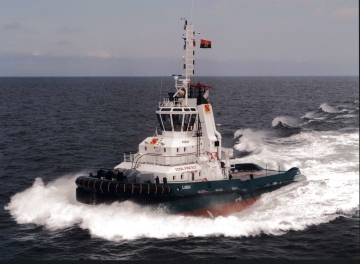 |
Luegi
2 x 2,758 bhp, blt 2001 by Damen Shipyards, owned by Sonasurf |
|
|
Bourbon Maritime, the new entity combining all
the maritime activities of the Bourbon group and controlling 100% of Surf,
has intentions for the latter to become a key player in the deep offshore
sector. Since March 2001, Bourbon Maritime holds 50 % of the Brazilian
shipowner Delba Maritime. This new entity has signed three long-term time
charters with Petrobras for three AHTS of UT 722 class. These ships will
be built in the Brazilian shipyard of Fels Setal. Surf has also ordered a
ship for multipurpose works, class VS 4501 named 'Athena' with Keppel
shipyard in Singapore. This ship, 86,30 m long and 20 m wide, capable of
accommodating 82 people on board, fitted with a helideck pad and a crane
with a 100 tons lift capacity, will work on a long-term contract on
offshore oil production with TotalFinaElf Congo. It will be Surf's 'flagship'.
In addition, the joint venture Sonasurf (Sonangol, Surf) won the
ExxonMobil Angola tender, comprising 12 ships on long-term charter, namely
the entire maritime logistics for the Block 15 field. Together with
Eidesvik, Surf has also ordered two PSV of the VS 470 class in Norway.
The market is watching out for the first signs of a drop in the
utilisation levels and charter rates, which might occur with a number of
newbuildings due to be delivered. This is not the case for the moment,
outside the Gulf of Mexico, and in particular PSVs continue to be much
sought-after and their rates remain high.
|
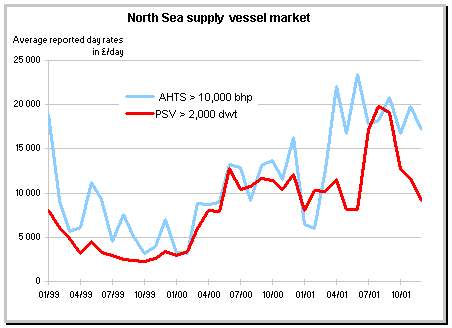
|
| Drilling |
|
|
|
The tendency towards consolidation in this
sector, which has been going on for several years, will probably come to
an end due to lack of valid candidates, following the merger of two big
Texan drilling companies, Global Marine (Houston) and Santa Fe
International (Dallas). The entity GlobalSantaFe has given birth to the
new number two in the sector, behind TransoceanSedco and in front of Pride
International, now number three, following the acquisition of Marine
Drilling Co. The new company's headquarters are in Houston and owns 90
drilling platforms working world-wide. These recent mergers will enable
the new entities to take major positions in the market and allow
exceptional growth prospects with substantial economies of scale on
overheads, giving a better evaluation of their share prices on the stock
market.
The market of jackup rigs has remained steady with utilisation rates in
the North Sea and West Africa over 80 %. It has recently dropped in the
Gulf of Mexico down to a level of 67 %, due mainly to a sharp drop in the
price of natural gas. In Brazil, utilisation of jackup rigs remained at a
level of 100 % throughout the year. South-East Asia also saw very high
utilisation rates around 86 %. During the course of the year 2001, the
jackup rig market largely contributed to the profits of drilling
companies, although a substantial decline in the levels of activity are
foreseen for 2002, and the extent will largely depend on the way the North
American gas market moves.
The utilisation rate for semi-submersibles has remained high all over
during the course of this year, and 43 out of 47 semi-submersibles located
in the North Sea are working at the end of 2001. All the modern drilling
ships with dynamic positioning, with the exception of some for technical
reasons, were employed under contract by the end of 2001.
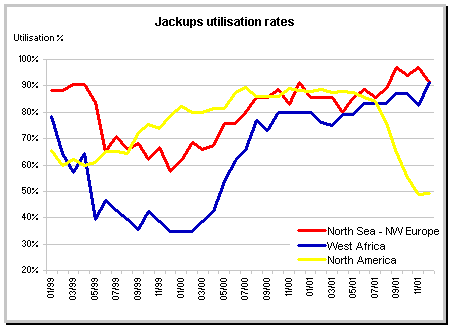
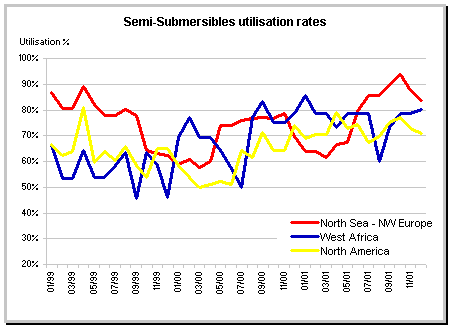
|
The market for building mobile drilling rigs
(with eight firm contracts) saw orders confirmed by SantaFe Drilling in
Singapore for two jackup rigs and two semi-submersibles, and also Maersk
Drilling declaring an option with Hyundai for a second jackup. These two
units will be the two largest in the world with legs of 205 metres,
allowing drilling in regions like the North Sea in depths of over 150
metres. The order by Atwood with Keppel Fels, Singapore, for a large
jackup of Mod V class, should be noted, as well as the Rowan Drilling
order in its own shipyard at Vicksburg for a jackup of Tarzan 250 class
and that of Maersk Drilling for a semi-submersible with a new design, DSS
class 20, which will be assembled by Keppel Fels Singapore in Azerbaidjan,
and which has already been fixed for three years with ExxonMobil. The
discoveries and drillings for developing numerous deep water reserves such
as those cited above, will continue to support the overall demand for
semi-submersibles, as well as for drilling ships with dynamic positioning
navigation such as 'Pride Africa' and 'Pride Angola', ships of IHC
Gusto 10,000 class having acquired a reputation for reliability.
|
| Construction
and underwater work |
|
|
This sector of the offshore market has
continued to consolidate itself. Technip and Coflexip have come together,
the latter having earlier acquired the deep water department, Aker
Deepwater of the Norwegian Aker, which holds amongst others the licences
for constructing of Spar platforms. The new company Technip-Coflexip has
resulted in the creation of the fifth largest oil service group in the
world, controlling the full range of activities from upstream to
downstream. This new entity employs 18,000 people and has achieved a
pro-forma turnover of 4.5 billion euros in 2000.
The new venture between the American Halliburton and the Norwegian DSND
should also be mentioned since it contributes to expand Halliburton's
services in the scope of underwater work sector.
The pipe-laying and underwater construction markets should grow by 60 %
in the next five years under the assumption of a steady rise in demand for
offshore oil and gas. However we should not forget that the offshore
industry is intrinsically cyclical, due to the effect of the price
fluctuations for oil and gas, and the variable lifecycles of investments,
depending on specific regions in the world. The development of pipe-laying
at over 500 metres depth at sea calls for highly sophisticated pipe-laying
vessels which could lead to an increased competition in this specialised
market, nevertheless, the mere fact of having the right ship may give a
substantial advantage to the extent that the main operators then have
construction projects technically in place ready to be executed. Anyhow,
in most cases, subsea contractors had or will have to order such kind of
modern asset on a speculative basis. In this respect, Dutch contractor
Heeremac, has committed more than $160 million this year to the up-grading
of its laying and lifting platform 'Balder'. We can reasonably assume
that large vessels capable of operating world-wide will take advantage of
the fluctuations in the oil and gas prices, and seek employment in the
most advantageous regions.
|
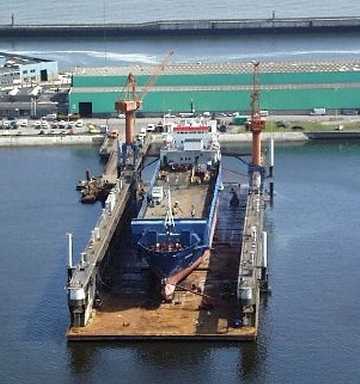 |
Floating dock - 16,000 t lifting capacity, sold by Flender Werft to Dunkirk Port Authority |
|
| EPC
(Engineering, procurement, contracting)
|
and FPSO (Floating production
storage and offloading vessels)
|
|
|
The EPC market, linked to the engineering,
construction and installation of necessary structures for oilfield
production, witnessed a significant improvement this year. There were a
number of noteworthy contracts of impressive technical and financial size,
mainly in the Gulf of Mexico and West Africa, such as Shell Nakika (GOM),
Chevron Sanah (Angola), Exxon Kizomba A (Angola), Shell Bonga (Nigeria),
Conoco Belanak (Indonesia), BP Crazy Horse (GOM). This latter oil field
has estimated reserves of one billion barrels situated 125 miles offshore
New Orleans, and calls for the construction of production platforms with a
unit price of roughly $500 million each, allowing production at depths of
2,000 metres.
Despite a certain number of projects which are experiencing delays in
approval, the fundamentals remain strong, given the importance of projects
still under offer and the maintaining of very high development budgets.
Examples of such projects are: Exxon Erha (Nigeria), ChevronTexaco Agbami
(Nigeria), TotalFinaElf Dalia (Angola), BP Plutonio (Angola), and Chevron
BBT.
Competition between the main prime contractors becomes fierce as soon
as the need of a drydock for the construction of a floating structure
comes into play. Access to the right shipyard for constructing and adding
components remains a vital aspect for such work, but this situation should
ease with the slow-down foreseen in shipbuilding in 2002. There is also
the gradual phasing out of the Norwegian EPC contractors with the merger
between Kvaerner Oil & Gas and Aker as well as the takeover of Moss
Maritime engineering by the Italian Saipem.
On the other hand, the surge of HHI offshore as a key player has been
more than ever confirmed.
Credit should be given to the technical success of 'FPSO Girassol'
operated by TotalFinaElf, at a depth of 1,400 metres, 200 km off the
Angolan coastline. This is the biggest unit of its class currently in
service, (300 m x 60 m x 30 m) on which there is 25,000 tons of oil
processing equipment on the deck of the barge. It contains accommodation
for 140 people and has a storage capacity for two million barrels of crude
oil. The FPSO started operating in December 2001 with projected production
of 200,000 b/d rising to 300,000 b/d.
The leased FPSO market also saw a sizeable expansion this year. One
currently expects up to 40 new units due to come into operation within
five years, this figure also includes the units, which will be fully owned
and operated by oil companies, bringing a total of some 110 units
throughout the world by the end of 2005. There are today 68 FPSOs
operating of which 33 are on long-term hire to operators. West Africa and
Brazil remain the two main markets for this type of business.
The year 2001 saw a record number of contracts awarded, which confirmed
SBM's leading position. Among the main contracts, there were two generic
FPSOs for Exxon (SBM), the replacement of the 'P36' platform in Brazil
by a leased FPSO, similar to 'FPSO Espadarte', the 'FPSO Doba' for
Enterprise Oil Brazil (Modec), Soekor, Sable Field (Bluewater), the very
big FSO for Exxon Chad/Cameroon (Modec), and the newbuilding FPSO for
TotalFinaElf in Libya (Exmar Offshore). In West Africa and Brazil the
standard size is two million barrels.
The main changes in this sector saw the acquisition of the Singapore
Nortrans by the Norwegian specialist in drilling and furnishing platforms,
Prosafe, as well as the acquisition of two FPSOs, 'Berge Hugin' and
'Navion Munin' by the Dutch contractor Bluewater. The latter now holds
a dominant position in the North Sea.
At the start of an era of heavy conversions for such projects, the main
shipyards in Singapore have largely confirmed their predominant position
in this sector.
| Cable laying
vessels |
|
|
|
The Internet boom and the correlated
extraordinary expansion of telecom which came to a head in 2000, led to
orders being placed for a number of cable layers and underwater telecom
system repairing ships. The big companies constructing optical fibre
networks then projected a steady increase in international networks. Some
cable laying vessels were ordered by owners who previously had no
experience in this business. It is the first time since sea laying
operations started back in the mid 19th century, that this sector has seen
such a deregulation and such an explosion.
In 2001 the bursting of the financial bubble of TMT (Technology, Media,
Telecom) companies has led to a reduction in the investment budgets in
this sector and a number of underwater optical fibre projects have been
abandoned.
Cable laying vessels started being delivered by the construction and
conversion shipyards at the end of 2001, but will be arriving on the
market in greater numbers in 2002. Their arrival unfortunately comes at
the time when the cable laying sector is feeling the pinch. Key players in
this area are looking for solutions to overcome this downturn.
It is likely that older cable laying vessels will be progressively
dismantled and/or scrapped, and that some units could be transformed so as
to make them viable for offshore business, in particular for use as ROVs
(Remotely operated vehicle), support vessels. In addition, some
construction and conversion projects will be delayed. The main operators
have also decided to carry out a drastic cutback in numbers.
In conclusion it should be added that a number of converted or new
vessels will be used as maintenance ships on long-term contracts taken up
by the operators of these new systems. These contracts concern in
particular regions which have been newly equipped such as Africa, the
Indian Ocean, and the Asian arc (Japan, China, Singapore), which will give
certain units employment and thus ensure a steady revenue over years to
come.
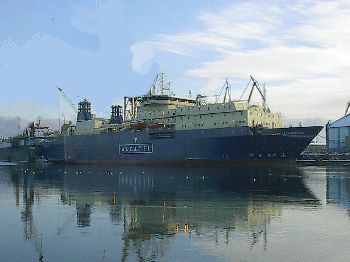 |
Lodbrog
redelivered by Remontowa, to ASN Marine A/S after an extensive conversion work from a former roro vessel into a cable layer |
|
|
* * *
Concerning BRS, and in line with the maxim
frequently used by our American friends to "think positively",
we advise our readers, who are not yet informed, that we have opened in
May 2001 an office in Houston (Texas), specialising in the offshore sector
and run by Americans: Mr. Dave Weinhoffer (director), assisted by Mr. Jon
Thielemann and Mrs. Rola El Zoor. We trust that the European
"savoir-faire" and the French touch in the field of shipbroking,
linked to the skills of American management, will allow us to serve the
best interests of our American and international clients.
|
Shipping and Shipbuilding Markets in 2001
I N D E X
|